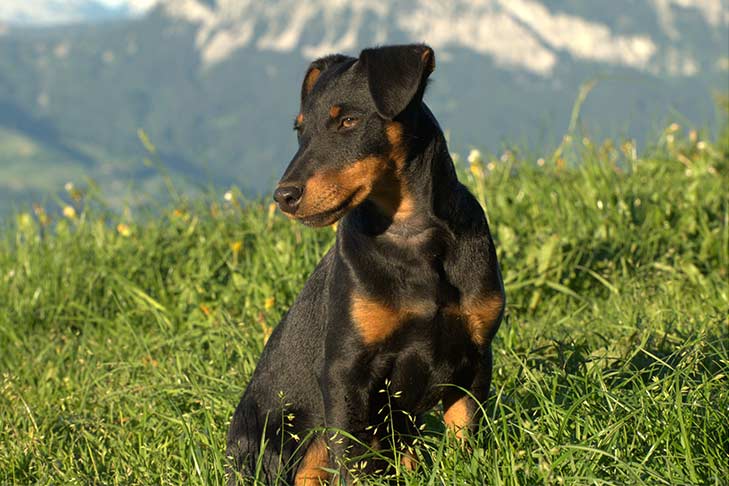
Home » The Jagdterrier: A Working Terrier with the Heart of a Hunter

Some Terriers are working Terriers and then there’s the Jagdterrier. This German original is a formidable hunter—skillful when it comes to dispatching quarry, certainly—but with an energy level that puts its British and Irish cousins to shame. The tenacious “Jagd” is as handsome as he is hard-wired, but this doesn’t mean he’s just another pretty face. In fact, the breed is anything but angelic. The Jagdterrier is a devil on the trail and a demon in a hole. Hunting is his birthright and he often bears the scars to prove it.
To help us introduce the Jagdterrier to ShowSight readers, Richard Reynolds has kindly answered our questions about the breed’s development, its unique temperament and its usefulness as a hunter. — Dan Sayers
The Jagdterrier (pronounced yockt-terrier) is a German working Terrier originally bred to hunt fox and badger below ground. In the eyes of many it is the consummate hunting Terrier and a favorite amongst hunters the world over. Perhaps its most valuable quality is its unique temperament and unequaled energy level. Most Jagds that have had the benefit of early socialization and training are friendly, always inquisitive and able to get along with other dogs. However, most everything else that breathes is regarded as legitimate quarry. That prey drive—along with the proper conformation to get the job done—makes it a valuable partner in any pack of hunting Terriers. “German Hunt Terrier,” “Deutscher Jagdterrier,” “Lovaki Terrier” and “Terrier de Chasse Allemand” are the names by which the breed is known.
Like most breeds, the initial origin and humble beginnings of the Jagdterrier are long forgotten. Perhaps the earliest beginnings were with Walter Zangenberg in the early 1920s who came into possession of four Terrier puppies. Some say these were black and tan Wire Fox Terriers, but I’m a bit skeptical of that. There were several others in Germany breeding along the same lines as early as 1911.
Between the two World Wars, there was a movement in Germany to eradicate non-native game species and reinforce native breeds. Lutz Heck was a zoo keeper and dog fancier who took up that challenge and, along with his brother Heinz, bred a lot of German Hunt Terriers. The Hecks were acquainted with Adolph Hitler and Hermann Göring and Göring took up the challenge of breeding Jagdterriers. At one time during the war, Göring was reputed to have 700 dogs in his kennel. A few left to go to hunters, but for the most part the kennel served as a facility to improve and solidify the temperament and conformation of the breed. While this sort of thing may be objectionable to some, it is the same concept that has been applied by organized foxhunts. The hounds produced by the hunts have evolved over centuries whilst Jagdterriers became a distinct breed in a couple of decades.
The Nazis don’t get all the credit for the breed’s development. There were and are dedicated breeders—nearly all of them hunters—working through the Deutscher Jagdterrier-Club which is similar to a US parent club, but on steroids. For all of this widely spaced effort, the breed remains remarkably consistent, unique and stable.
From what has been written, the original intent was to breed a German Terrier for use in hunting badger and fox in the earth; a true working Terrier. The smaller size and smaller girth of the original dogs lend credence to this initial goal as does the current FCI standard. (The standard places an upper height limit of 16” at the withers.) The simple fact is that there is no real boundary to the breed’s talents. It wasn’t long before it was adopted by hunters of wild boar, deer and even bear. As the breed slowly spread throughout Europe its job description diversified to hunting all types of game as well as blood trailing. In the US, the breed found immediate favor when they were brought here between 1951 and 1954. The Jagd’s diverse hunting (and retrieving) skills made it a quick favorite with hunters of boar in Texas, Florida and Louisiana.
This superior ability to hunt pigs has proved to be both boon and bane to the Jagdterrier. While the breed was developed for earthwork, even the Germans quickly recognized its ability on boar. The 16” height limit quickly gave way to the larger, faster, stronger dogs that could more easily handle the larger quarry. In the US, fully 80% of the Jagds are entered to boar, while the remainder are entered to raccoon, fox or nutria. A very few of us hunt rats and woodchuck. (“Entered” means simply that a hound or Terrier has been trained to hunt and has successfully hunted a certain type of quarry. In foxhunting, young hounds are “unentered” for their first year with the pack. There are unentered classes at hound shows. It’s less formal in Terriers.)
One has only to look at a Jagdterrier to see the evident similarities to many of the British Terriers, particularly the older strains of Patterdale, Lakeland, and Fell Terriers. There is a lot of resemblance to the old English Red Terrier as well. Each of these dogs was purpose-bred and their similarity of purpose would necessarily require similar conformation. But a visual comparison may be misleading. The tan point markings of many Jagdterriers (resembling the Dobe, Rottie or even some Dachshunds) give rise to the suspicion that one of these German favorites might be hidden somewhere in the mix. Today’s breed experts deny that theory.
The most telling similarity to all Terriers though, is the typical prey drive and affinity for earthwork and hunting that is the cornerstone of all the Terrier breeds. In the Jagd, these qualities have been bred to the highest level and are instantly recognizable. The coat, the straight shoulder, the moderate stop and strong tail all speak to the Terrier breeds. There is none of the dignity, restraint or biddability of the German working breeds.
It really doesn’t differ all that much in appearance or conformation. It’s sometimes got a better broken coat than the rest and it appears a bit leggier than many. Jagds are free of many of the congenital anomalies that beset other Terrier breeds. We are now testing for Primary Lens Luxation (PLL), but it is not endemic in the breed. My thinking is that it should be easier to breed good Jagds because of the rock-solid gene pool that still exists today.
Jagds are undeniably attractive and never more so than to knowledgeable dog people (like EL and LG) who can envision what they could do with the breed. They are not as showy as a WFT, not as racy as a good Irish and far less elegant than a fine Welshman. No other Terrier projects a look of sheer evil along with the innate ability to fulfill that promise.
It’s the temperament though, that is the major difference. That temperament is responsible for many Jagds ending up in shelters across the country. The uncontrollable urge to hunt and an energy level higher than anything imaginable means that the average owner lasts about four weeks before giving up and surrendering the dog.
I’ve hunted with Jagds owned by others for years. For the most part, they were too “hard” for my style of hunting or too large for our smaller quarry on the East Coast. Mostly though, I had a team of Dachshunds and Norfolks that satisfied my needs very well. Three or four years ago I was privileged to hunt with a well-known rat hunter in California who had recently acquired a Jagd bitch. He allowed me to hunt her and I found her to be everything I wanted in a Terrier for woodchuck (as well as rats). While most of our group keeps Patterdales, I thought I’d try a Jagd and the rest is history.
As a dog fancier? Not much. They are hard to keep, hard to train and destructive if they don’t hunt regularly. People and other dogs appear to be “protected species” to a Jagd, but virtually everything else is regarded as quarry. Early on I noticed that most folks keep their Jagds tethered. I was told that proper Jagd husbandry involved tying the dog on a thick chain out back of the property and throwing it a live chicken every other day. We don’t do the live chicken bit, but my Jagds are tethered out
of necessity.
As a hunter though, I am thoroughly enamored of this great breed for its determination, relative freedom from congenital problems and the conformation required to do the job I require, which is true earthwork. It doesn’t hurt that the breed also excels at rat hunting. You still need a team of different breeds to hunt efficiently, but the Jagdterrier is a really effective all-rounder.
One noted breeder is the US is carrying on a project to breed back to one nearly perfect male. I asked him why this particular dog and he cited five qualities: size; hunting ability; conformation; and the predictable quality of his offspring. The fifth quality? I was told, “He healed up quickly.” I’ve come to recognize this virtue only lately.
We try and hunt at least one day a week and, if possible, two or three. “Rommel”, my number one Jagd has been hunted on fox, woodchuck and, of course, rats. At a year-and-a-half, he has firmly developed his instinct and hunting ability. His skill and efficiency in dispatching quarry still need to be honed to prevent self-injury, but he speaks the truth when indicating quarry and is an overall joy to hunt with. Moreover, like any good Terrier, he will hunt with and for anybody.
Rommel easily qualified for a Junior Earthdog title in two consecutive tries. A perfect record. However, the idea of leaving the liner without quarry in his mouth is a foreign concept, so it is doubtful that he will ever progress to a Senior Earthdog title or beyond. The hunting instinct is far stronger than any recall command, so any activity that involves being off-lead for very long is out of the question. I’m still looking for a training professional that can get him to “Come.” I think we may try Fast CAT if the opportunity arises.
Amongst the many litters of Jagds that are born in the US, Rommel came from one of the few that included conformation in its planning. With that in mind, he has been shown in three AKC Open Shows, winning Best in Show at two of them and the FSS Group at the third. That was enough to gain his Certificate of Merit, the FSS equivalent of a Championship. I had intended to get into some more shows, but his hunting commitments and my judging assignments have so far made that impossible. Owning a working Jagd brings new meaning to “honorable scars” and I can only hope that any future judges will be forgiving of his active and eventful career.
The American Hunting Terrier Association, Inc., the Jagdterrier breed club, provides most of the stewardship of the breed in the US. Several of its members have imported some of the best breeding stock that Europe has to offer.
The club holds several multi-faceted events every year which includes “Pig Bays,” conformation judging and several other field events. It’s a hunting club for a hunting breed. Still, the majority of breeders are as skilled and as conscientious as any in our world, and are looking after the welfare of this still-evolving breed. The AKC Foundation Stock Service provides the largest reliable registry for the breed and will ultimately bring together the breeding records and pedigrees that are currently scattered throughout several registries. That same FSS registry has opened the door for the Jagdterrier to AKC performance and companion events as well as AKC Open Shows. Like most emerging breeds, there is some resistance to full AKC recognition. For now, the AHTA and its breeder members are doing a first-rate job of promoting the breed while protecting its conformation and singular temperament and ability.
Globally, the breed is fully recognized by the FCI (Group 3, Section 1 Large and Medium Sized Terriers, 103) and the FCI breed standard is in
use worldwide. Relatively small numbers are shown at Crufts and 20 German Hunting Terriers were entered at the recent World Dog Show in Amsterdam. Nearly all the major activity globally is centered around hunting and there are many great dogs that never see the inside of a conformation ring. National breed clubs, particularly those in Poland, Slovakia and Hungary are the base of most activity. For all of that, it is the individual hunters worldwide, who may or may not even register their dogs, that are responsible for the preservation and advancement of the breed.
